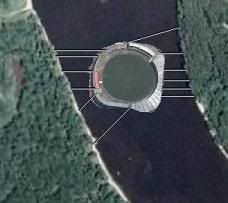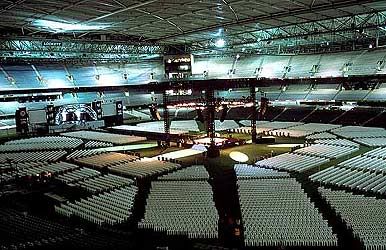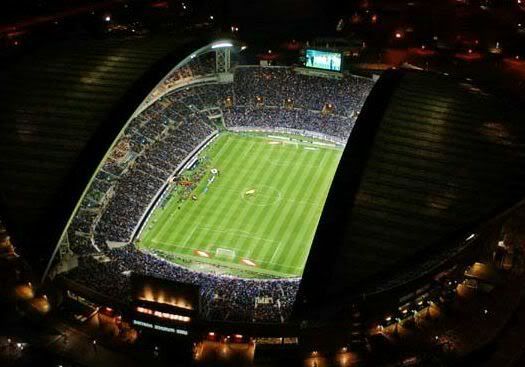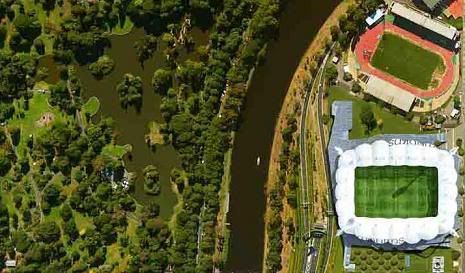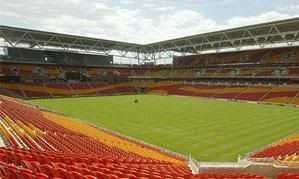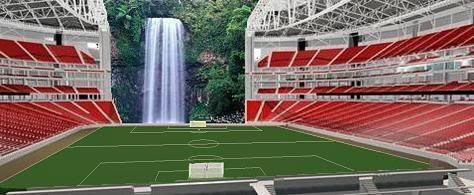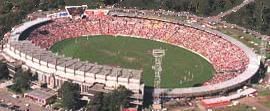Errinundera's NSWC Football Grounds
Errinundera is constantly expanding the number of grounds suitable for World Cup matches. The Errinundera Football Association has an ambitious program to upgrade the facilities of its member clubs.
Contents
- 1 Football Grounds
- 1.1 The Amphitheatre
- 1.2 The B.C.G. (Bonang Cricket Ground)
- 1.3 Big Eye
- 1.4 The B Triple R (Bemm River Recreation Reserve)
- 1.5 The Cavern
- 1.6 Delegate Stadium
- 1.7 Flatlands Biodome
- 1.8 Frosty Hollow
- 1.9 Glenferrie
- 1.10 Liberation Stadium
- 1.11 Milosis Coliseum
- 1.12 National Downfall Stadium
- 1.13 New Glumbog
- 1.14 Ootopia Forest
- 1.15 Stade de siaros
Football Grounds
The Amphitheatre

- Location: Big Tree Camp
- Capacity: 20,000
- Notable Feature: Semi-circular with panoramic views
Just outside Big Tree Camp is the spectacular Big Tree Camp Amphitheatre, home to the Monkeytop United Football Club. It is not actually a stadium as such. From the outskirts of Big Tree Camp the Rodger River valley falls away quite steeply. A gigantic stone amphitheatre has been constructed on one particularly steep section. At its base there is a flat area just large enough for a football pitch. 20,000 people can sit in an arc around the pitch while the players’ facilities are mined into the hillside under the amphitheatre. Like the Milosis Coliseum in McKillops Bridge and the Downfall Stadium in Errinundera, splendid views form a backdrop to the football action. But, whereas the other 2 stadia are only open at the ends, the Amphitheatre is half a circle. Quite simply, the outlook is vast. It is not uncommon for games to be played above the clouds with only the mountain peaks poking through.
Floating: that is the oft-used word to describe the heady experience of a visit here.
The B.C.G. (Bonang Cricket Ground)
</div>- Location: Bonang
- Capacity: 101,000
- Notable Feature: Home of the Gonads
Bonang confidence in its footballing future is reflected in the city’s decision to build the largest stadium in the nation: the 101,000 seat Bonang Cricket Ground. The stadium consists of two great semi-circular stands designed and built by competing companies.
Why that name? The ground’s primary use for over a hundred years has been as a cricket ground. It will continue to be used as such in summer although the few thousand that attend cricket matches will be dwarfed by the stands.
The mayor of the city, kirnerj, had the World Cup in mind. “We saw this as a chance to stage something of a coup. No other city in Errinundera has the resources to build anything to match it.” She is absolutely correct: the biggest matches will be held at the stadium.
Big Eye
</div>- Location: Malinns
- Capacity: 43,000
- Notable Feature: Shaped like an eyeball with eyelids that open and close
Brodribb Province's first World Cup football stadium may not be the largest but it's arguably the most spectacular. The stadium is a marvel of engineering, as well as a magnificent piece of architecture. The name "Big Eye" is quite apt, since the stadium is shaped like a big eye looking upward, with a roof that can open and close like an eyelid. The round stadium roof is suspended on the core stadium base, and from a distance it almost looks like it is some sort of huge flying saucer, hovering just above the ground.
It was chosen by Architecture Week magazine as the best stadium design in the world, in 2129. The stationary portion of the roof is clad in titanium, giving it a futuristic appearance yet the interior is very light and airy. When closing, the roof sections move up from the two sides along the main beam arch, meeting exactly above the center of the field, just like an eyelid closing shut.
Malinns is something of a newcomer to the Premier League but, with a brand new stadium, and a rapidly growing supporter base, the Locomotives believe they are on track to better things.
</div>The B Triple R (Bemm River Recreation Reserve)
- Location: Bemm River
- Capacity: 35,000
- Notable Feature: Built in the middle of the river
LIke so many cities, towns and structures in Errinundera, The Bemm River Recreation Reserve takes advantage of its natural environment. Built on an island in the centre of the river, the stadium expanded over the years so that, now, no trace of the island is visible from the riverbanks. The football ground gives the illusion of rising out of the river itself. Indeed the B Triple R, as it is affectionately called, can only be accessed via skywalks that bring the fans into the stadium through its roof. Someone canoeing down the river may think they are in a pristine wilderness until they round a bend in the river and see graceful parabolic fingers stretching from all directions out of the tree canopy and meeting at the admittedly rather ugly edifice in the middle of the river.
The B Triple R was one of the first large stadiums built when football was introduced to Errinundera and has therefore been well and truly overtaken by later developments. A new stand has increased the capacity to 35,000 and facilities, while not bad, are only adequate.
</div>The Cavern
- Location: Mount Ellery
- Capacity: 52,000
- Notable feature: Undergound, below 3,000m Mount Ellery
In order not to fall behind its rival cities in the Errinundrian Football Association, the City of Mount Ellery decided to build a modern football stadium - underground. The engineering challenges of building a football stadium underground were daunting. A 52,000 seat capacity ground was calculated as the largest practicable and a seven-year excavating and furbishment program was anticipated. Sadly for the ambitions of the Mountain Folk, other cities have built or are building larger stadiums.
The major advantage of an underground stadium is obvious: weather has no effect on the games. In winter the temperature outside can be minus twenty degrees Celsius but patrons will be snug and warm away from any blizzards in an environment where the temperature varies by less than 2 degrees all year round. Similarly in summer, there is no trace of the hot north wind that can bedevil the nation.
In typical Errinundrian bloody-minded fashion, the local administration is determined to have a natural grass playing surface. This has created considerable difficulties. The solution is to suspend enormous sun lamps from the ceiling that, during daylight hours when the ground is not being used, are lowered to only one metre above the grass. Automatically computer controlled, the lights imitate exactly the brightness and wavelength of light falling on a particular chosen spot in the outside world.
</div>Delegate Stadium
- Location: Delegate
- Capacity: 63,700
- Notable feature: Beautiful winged roof
With the completion of their new home facility the Forest Spirits are sure to continue as one of the strongest teams in the Premier League in recent years. It is perhaps the most beautiful and most state-of-the art facilities in Errinundera. With soaring triangular sails covering both banks of seats, and an intimate atmosphere, many feel that this stadium will become one of the most popular among football fans.
The rise of the Delegate Spirits as a Premier League power has provided scenes of awe-inspiring impact when the stadium fills to the rafters with a sea of red-shirted supporters. If you are visiting Errinundera and have a chance to take in a match, Delegate Stadium should definitely be one of the first stops on your itinerary.
</div>Flatlands Biodome
- Location: Waratah Flat
- Capacity: 36,000
- Notable Feature: Lightweight bioframe roof
It was clear to the Waratah Flat Football Club that their development in the EFA was being retarded by the old stadium with its limited capacity and primitive facilities. The newly completed stadium holds 15,000 more fans than its predecessor. The amazing bubbly bioframe roof is a work of art. Patrons and players alike say the stadium has a character all its own.
Frosty Hollow
(See Frosty Hollow article)
- Location: Rooty Break
- Capacity: 61,000
- Notable Feature: Sunken pit with giant forest up to edge
In the early days of NSWC Frosty Hollow was the designated national stadium and the official ground for all Errinundera’s home games during qualifying. Located on the outskirts of Rooty Break, it is the home ground of Rooty Break and, formerly, First Creek Falls. When FCF relocated to the Downfall Stadium the Rooty Break club decided that a major overhaul of the stadium was required if they were to continue to host international matches.
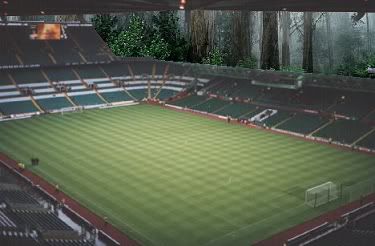
Like the B Triple R in Bemm River, fans enter the stadium through its roof. The two stadia, however, could hardly be more dissimilar. Located on the Errinundera Plateau, Frosty Hollow is well and truly landlocked. The notable thing about the arena is that, instead of being built above ground, a gigantic pit was excavated into the ground. All the while, the constructors took great care not to damage the gigantic trees that grow right up to the edge of the stadium. "Errinundera is forest and forest is Errinundera," explained construction manager, eservat, at the time, "and so the idea is for these magnificent trees to utterly dominate the view from inside the stadium. The outside edge of the roof is only half a metre above the surrounding ground. From inside, what you will see is the illusion of a forest growing out of the roof. The largest trees are over 120 metres high and have a diameter of nearly 20 metres. Compare this with the height from the playing surface to the roof, which is about 30 metres. We aim to give the impression of being in the very heart of the forest."
Frosty Hollow is notorious for its weather: fog, severe frost, lightning, snow storms. In the most notorious incident, vice-captain ubhashinim was killed when a tree fell on her during a World Cup qualifyng match.
Home games against Errinundera's most bitter rivals are usually scheduled here.
</div>Glenferrie
- Location: Bola Mine
- Capacity: 53,000
- Notable Feature: First world class stadium to be built in the Goolengook province
Bola Mine is arguably the nation's ugliest city. Ugly perhaps, but the enormous wealth generated by the city's gold mine enabled it to commence building a world class stadium while the team was still in the 2nd Division. No matter, by the time it was completed the Hawks had been promoted to the Premier League with a bright future. The stadium and the rejuvenated team are the pride of the city.
Liberation Stadium

- Location: McKillops Bridge lower city
- Capacity: 83,000
- Notable feature: Twice as big as the Milosis Coliseum
The shenanigans around the building of the Liberation Stadium rival the spectacle of the structure itself. Perhaps the most bitter rivalry in Errinundrian football is between the two McKillops Bridge teams - the Milosis White Guards and the McKillops Bridge Kingfishers. The Kingfishers are the most successful team in the nation and, until the recent completion of the new ground, played their home games at their rival's stadium. Tiring of playing hosts to their more successful lodgers the White Guards evicted the Kingfishers. Sensing the opportunity to cripple the competition leaders, the other clubs refused to share their grounds forcing the Kingfishers to forfeit almost all their home games for one season. The ground has now been completed and the dominance of the association's overlords can now be renewed. Second only in capacity to the B.C.G. the Liberation Stadium is further evidence that the great northern cities of Errinundera are the nation's football powerhouses.
Milosis Coliseum
- Location: McKillops Bridge upper city
- Capacity: 41,000
- Notable feature: clifftop stadium with panoramic views
Sixty metre granite cliffs dominate the western bank of the Snowy River in McKillops Bridge. The unusual feature of the McKillops Bridge Coliseum is that the pitch goes almost to the edge of the cliff affording a dizzying view for players and spectators alike. Fans in the top row seats can see far into the east of Errinundera. A secure mesh fence prevents people and players from falling over the edge. The ground is the home of the Milosis White Guards who, much to the chagrin of the upper city folk, seem always to play second fiddle to their lower city rivals.
National Downfall Stadium
</div>- Location: First Creek Falls
- Capacity: 64,000
- Notable Feature: Hairy Man Falls dominates one end
The EFA decided to build the National Downfall Stadium outside the capital city as a showpiece combining the beautiful game with the natural environment. To meet this goal the stadium was erected lower down the escarpment on a spot that was severely degraded by prospectors over a hundred years ago. The location, known as Downfall, is at the base of one of several waterfalls and cataracts downstream from First Creek Falls.
With grandstands only along the sides of the pitch, the gap in the northern end of the arena is dominated by the waterfall that seems to fill it entirely. The gap in the southern end looks down the Errinundera River Valley towards Bemm River. At night the lights twinkling from between the trees in the small town of Errinundra below the escarpment are visible from the stadium. A cable car system connects the stadium to the nearby First Creek Falls which cannot be seen from the ground.
There were initial concerns that the shape of the stadium would create a wind tunnel. Extensive tests have allayed these fears. The escarpment above the ground and the steep ridges on either side create a pocket of still air. Spectating here is a memorable experience.
New Glumbog
- Location: Rodger River
- Capacity: 78,000
- Notable feature: The fans don't chant or cheer - they hum
You may think that humming is a mundane activity. Well it is, unless you hum along with 78,000 other people. And that’s what they do at the Glumbog Arena in Rodger River. It is an unnerving experience for visiting teams. There’s no chanting, no clapping and only occasionally does the crowd burst into a full-throated roar. Depending on the state of the game the volume goes up and down and the pitch rises and falls. There are staccato bursts and long legato swoops. It is intensely emotional and unlike anything you may have heard before.
Why the name Glumbog? No-one is completely sure. Maybe because it rhymes with hum. Maybe its because in the early days of the EFA the former ground was notorious for its playing surface. Maybe it’s the reputation for pessimism that hangs about the Rodgerers.
Ootopia Forest
- Location: Fanny Moo
- Capacity: 45,000
- Notable feature: Built in the centre of a broad, shallow gully with rainforest all around
Ootopia was formed from the amalgamation of three clubs (Cobb Hill, Fanny Moo and Lilly Pilly Creek) from the western end of the great plateau. With the extra resources available the new club, representing many small forest villages, had the confidence to build a modern stadium. Like Frosty Hollow (but not as weird) the stadium is set in the middle of the rainforest. Unlike Frosty Hollow the ground is above ground (so to speak), however the forest on either side of the gully is clearly seen from within the stadium. An enchanting place to spectate.
Stade de siaros
</div>- Location: Deddick
- Capacity: 80,000
- Notable Feature: Named after siaros, the Civil War hero who died at the 1892 Battle of the Pass.
As the largest city in the Deddick region (and only exceeded in size in Errinundera by Bonang), the Deddiquois were sick of playing the poor cousins to their regional rivals McKillops Bridge and Milosis. A massive investment in their local competition included a new stadium. Construction was not without its controversies. In particular, many felt that a major football stadium adjacent to a national monument - the site of the Battle of the Pass - was tantamount to desecration. The construction site was torched twice before football fans from Deddick and elsewhere mounted their own watch. Inevitably, pitched battles followed. Wags called it the Second Battle of the Pass. It is said that total injuries exceeded those of the original battle.


